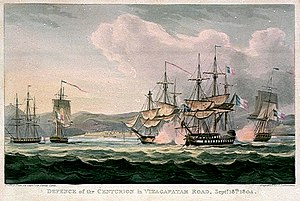
The Battle of Pulo Aura was a minor naval engagement of the Napoleonic Wars, fought on 14 February 1804, in which a large convoy of Honourable East India Company (HEIC) East Indiamen, well-armed merchant ships, intimidated, drove off and chased away a powerful French naval squadron. Although the French force was much stronger than the British convoy, Commodore Nathaniel Dance's aggressive tactics persuaded Contre-Admiral Charles-Alexandre Durand Linois to retire after only a brief exchange of shot. Dance then chased the French warships until his convoy was out of danger, whereupon he resumed his passage toward British India. Linois later claimed that the unescorted British merchant fleet was defended by eight ships of the line, a claim criticised by contemporary officers and later historians.

Charles-Alexandre Léon Durand, Comte de Linois was a French admiral who served in the French Navy during the reign of Napoleon Bonaparte. He commanded the combined Franco-Spanish fleet during the Algeciras Campaign in 1801, winning the First Battle of Algeciras before losing the Second Battle of Algeciras. He then led an unsuccessful campaign against British trade in the Indian Ocean and South China Sea in 1803, being defeated by a harmless fleet of the East India Company during the Battle of Pulo Aura and ending his cruise and sea-going career being bested in battle by John Warren in the action of 13 March 1806. Following the Bourbon restoration, Linois was appointed Governor of Guadeloupe. He supported Napoleon during the Hundred Days and so, on his return to France, he was forced to resign and was court martialled. Although acquitted, he was placed in retirement and never served again.
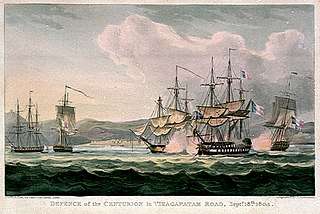
The Sémillante was a 32-gun frigate of the French Navy and the lead ship of her class. She was involved in a number of multi-vessel actions against the Royal Navy, particularly in the Indian Ocean. She captured a number of East Indiamen before she became so damaged that the French disarmed her and turned her into a merchant vessel. The British captured her and broke her up in 1809.
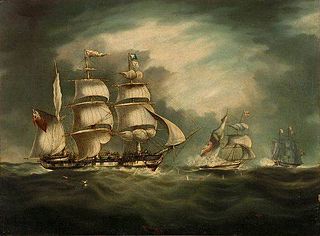
HMS Belle Poule was a Royal Navy fifth-rate frigate, formerly Belle Poule, a Virginie-class frigate of the French Navy that had been built by the Crucy family's shipyard at Basse-Indre to a design by Jacques-Noël Sané. She was launched on 17 April 1802, and saw active service in the East. In 1806 a British squadron under Sir John Borlase Warren captured her off La Palma in the Canary Islands. The Admiralty commissioned her into the Royal Navy as HMS Belle Poule. She was sold in 1816.

Pierre-François-Henri-Étienne Bouvet de Maisonneuve was a French Navy officer and privateer.

Jean-Jacques Rousseau was a Téméraire class 74-gun ship of the line of the French Navy, active during the French Directory, French Consulate and First French Empire. Renamed Marengo in 1802, she took part in Linois' operations in the Indian Ocean before her capture by the Royal Navy.

Linois's expedition to the Indian Ocean was a commerce raiding operation launched by the French Navy during the Napoleonic Wars. Contre-Admiral Charles-Alexandre Durand Linois was ordered to the Indian Ocean in his flagship Marengo in March 1803 accompanied by a squadron of three frigates, shortly before the end of the Peace of Amiens. When war between Britain and France broke out in September 1803, Marengo was at Pondicherry with the frigates, but escaped a British squadron sent to intercept it and reached Isle de France. The large distances between naval bases in the Indian Ocean and the limited resources available to the British commanders in the region made it difficult to concentrate sufficient forces to combat a squadron of this size, and Linois was subsequently able to sustain his campaign for three years. From Isle de France, Linois and his frigates began a series of attacks on British commerce across the Eastern Indian Ocean, specifically targeting the large convoys of East Indiamen that were vital to the maintenance of trade within the British Empire and to the British economy. Although he had a number of successes against individual merchant ships and the small British trading post of Bencoolen, the first military test of Linois squadron came at the Battle of Pulo Aura on 15 February 1804. Linois attacked the undefended British China Fleet, consisting of 16 valuable East Indiamen and 14 other vessels, but failed to press his military superiority and withdrew without capturing a single ship.

The Battle of Vizagapatam was a minor naval engagement fought in the approaches to Vizagapatam harbour in the Coastal Andhra region of British India on the Bay of Bengal on 15 September 1804 during the Napoleonic Wars. A French squadron under Contre-Admiral Charles-Alexandre Léon Durand Linois in the ship of the line Marengo attacked the British Royal Navy fourth rate ship HMS Centurion and two East Indiaman merchant ships anchored in the harbour roads. Linois was engaged in an extended raiding campaign, which had already involved operations in the South China Sea, in the Mozambique Channel, off Ceylon and along the Indian coast of the Bay of Bengal. The French squadron had fought one notable engagement, at the Battle of Pulo Aura on 15 February 1804, in which Linois had attacked the Honourable East India Company's (HEIC) China Fleet, a large convoy of well-armed merchant ships carrying cargo worth £8 million. Linois failed to press the attack and withdrew with the convoy at his mercy, invoking the anger of Napoleon when the news reached France.

The action of 13 March 1806 was a naval engagement of the Napoleonic Wars, fought when a British and a French squadron met unexpectedly in the mid-Atlantic. Neither force was aware of the presence of the other prior to the encounter and were participating in separate campaigns. The British squadron consisted of seven ships of the line accompanied by associated frigates, led by Rear-Admiral Sir John Borlase Warren, were tasked with hunting down and destroying the French squadron of Contre-Admiral Jean-Baptiste Willaumez, which had departed Brest for raiding operations in the South Atlantic in December 1805, at the start of the Atlantic campaign of 1806. The French force consisted of one ship of the line and one frigate, all that remained of Contre-Admiral Charles-Alexandre Durand Linois' squadron that had sailed for the Indian Ocean in March 1803 during the Peace of Amiens. Linois raided British shipping lanes and harbours across the region, achieving limited success against undefended merchant ships but repeatedly withdrawing in the face of determined opposition, most notably at the Battle of Pulo Aura in February 1804. With his stores almost exhausted and the French ports east of the Cape of Good Hope that could have offered him replenishment eliminated, Linois decided to return to France in January 1806, and by March was inadvertently sailing across the cruising ground of Warren's squadron.
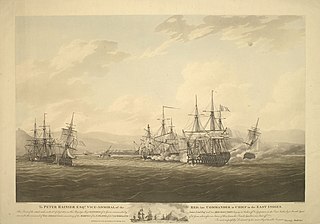
HMS Centurion was a 50-gun Salisbury-class fourth rate of the Royal Navy. She served during the American War of Independence, and during the French Revolutionary and Napoleonic Wars.
Sir James Lind KCB was an officer of the Royal Navy who served during the American War of Independence and the French Revolutionary and Napoleonic Wars. The son of James Lind, a distinguished naval physician, Lind also embarked on a career at sea, but served in a more front line role. After serving on a number of different ships he finally received his own command in 1800, but his first chance to show his ability came only in 1803 when in command of HMS Sheerness. Here he captured a French privateer after his imitation of a merchant ship encouraged the privateer to actually attack his heavily armed frigate. He then revealed the true nature of his ship and the hapless privateer had no choice but to swiftly surrender. Promoted to command the 50-gun HMS Centurion Lind had another opportunity to distinguish himself, when the convoy under his protection was attacked in the harbour of Vizagapatnam by a heavily armed French squadron under Rear-Admiral Charles-Alexandre Durand Linois. Despite being on shore at the time Lind hurried back to take command and supervise operations to resist the French, who though were able to capture one of the merchants, decided not to risk pressing the attack on the Centurion and withdrew. The survival of the Centurion in the face of overwhelming forces was hailed as a great achievement back home in Britain, with Lind being knighted for his efforts.

The Atlantic campaign of 1806 was a complicated series of manoeuvres and counter-manoeuvres conducted by squadrons of the French Navy and the British Royal Navy across the Atlantic Ocean during the spring and summer of 1806, as part of the Napoleonic Wars. The campaign followed directly from the Trafalgar campaign of the year before, in which the French Mediterranean fleet had crossed the Atlantic, returned to Europe and joined with the Spanish fleet. On 21 October 1805, this combined force was destroyed by a British fleet under Lord Nelson at the Battle of Trafalgar, although the campaign did not end until the Battle of Cape Ortegal on 4 November 1805. Believing that the French Navy would not be capable of organised resistance at sea during the winter, the First Lord of the Admiralty Lord Barham withdrew the British blockade squadrons to harbour. Barham had miscalculated – the French Atlantic fleet, based at Brest, had not been involved in the Trafalgar campaign and was therefore at full strength. Taking advantage of the reduction in the British forces off the port, Napoleon ordered two heavy squadrons to sea, under instructions to raid British trade routes while avoiding contact with equivalent Royal Navy forces.
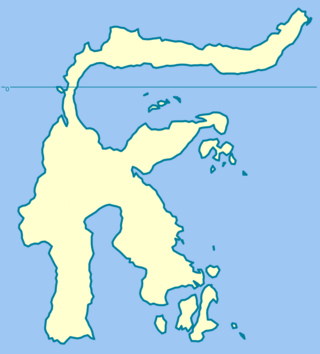
The action of 26 July 1806 was a minor naval engagement of the Napoleonic Wars fought off the southern coast of the island of Celebes in the Dutch East Indies. During the battle, a small British squadron attacked and defeated a Dutch force defending a valuable convoy, which was also captured. The British force—consisting of the frigate HMS Greyhound and brig-sloop HMS Harrier under the command of Captain Edward Elphinstone—was initially wary of the Dutch, mistaking the Dutch East Indiaman merchant ship Victoria for a ship of the line. Closer observation revealed the identity of the Dutch vessels the following day and Elphinstone led his frigate against the leading Dutch warship Pallas while Harrier engaged the merchant vessels and forced them to surrender. Only the corvette William escaped, taking no part in the engagement.

The Java campaign of 1806–1807 was a minor campaign during the Napoleonic Wars by British Royal Navy forces against a naval squadron of the Kingdom of Holland, a client state of the French Empire, based on the island of Java in the Dutch East Indies. Seeking to eliminate any threat to valuable British merchant convoys passing through the Malacca Straits, Rear-Admiral Sir Edward Pellew determined in early 1806 that the Dutch naval forces based at Java, which included several ships of the line and three frigates, had to be defeated to ensure British dominance in the region. Lacking the forces to effect an invasion of the Dutch colony, Pellew instead sought to isolate and blockade the Dutch squadron based at Batavia in preparation for raids specifically targeting the Dutch ships with his main force.

The action of 21 April 1806 was a minor engagement between a French frigate and British forces off South Africa during the Napoleonic Wars. The Île Bonaparte and Île de France constituted French outposts in the Indian Ocean, from which privateers and frigate squadrons could engage in commerce raiding and disrupt British shipping. After encountering a strongly escorted British convoy, the 40-gun Cannonière attempted to flee, but was rejoined by the 74-gun HMS Tremendous. In the ensuing battle, Captain Bourayne displayed superior sailmanship and managed to fend off his much stronger opponent by a combination of manoeuvers that rendered the batteries of Tremendous ineffective, and threatened her with sustaining raking fire. The French frigate thus managed to evade and escape.
Althea was launched at Calcutta in 1801. She made one voyage to Britain for the British East India Company. The French captured her in the Indian Ocean in 1804 and then kept her at Île de France where she served as a prison ship. When the British captured Île de France in 1810 they recovered Althea. She then resumed her mercantile career until she wrecked in 1812.
Charlotte was built at the Bombay Dockyard in 1803. She spent most of her career as a country ship, trading between India and China, though she did sail between India and the United Kingdom on occasion, and under a licence from the British East India Company (EIC). The French captured her in 1804 but she returned to British hands. She was wrecked in 1851.
Brunswick was launched in 1792 as an East Indiaman for the British East India Company (EIC). She made five complete voyages for the EIC before the French captured her in 1805. Shortly thereafter she wrecked at the Cape of Good Hope.

Upton Castle was launched at Bombay in 1793. She spent her career as a "country ship", that is trading in the Far East. She made some voyages to England, including at least one, in 1809, under charter to the British East India Company (EIC). She also participated in two military campaigns as a transport. The French Navy captured her in 1804, but she returned to British hands before 1809. A fire in 1817 destroyed her.
Dorsetshire was launched in 1800 as an East Indiaman. She made nine voyages for the British East India Company (EIC). In each of her first, second, and third voyages she was involved in a notable action. The remainder of her voyages appear to have proceeded without incident. She ceased sailing for the EIC in 1823 and was broken up c.1827.
